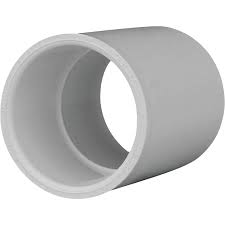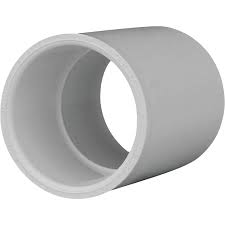PVC Coupling 1/2" to 10"
Please request a quote for pricing information.

PVC Coupling 1/2" to 10"
A PVC coupling is a fitting used to join two sections of PVC pipe together in a plumbing, irrigation, or electrical conduit system. Couplings come in various sizes to accommodate different pipe diameters and are available in various forms, including standard, slip, and threaded designs.
Here's a table showing the most common PVC coupling sizes with key dimensions:
PVC Coupling Size Table
| Pipe Size (Nominal) | Outer Diameter (OD) | Inner Diameter (ID) | Coupling Length | Type | Common Use |
|---|---|---|---|---|---|
| 1/2" | 0.840" (21.3 mm) | 0.622" (15.8 mm) | 1.25" (32 mm) | Slip | Joining two 1/2" PVC pipes |
| 3/4" | 1.050" (26.7 mm) | 0.824" (20.9 mm) | 1.25" (32 mm) | Slip | Joining two 3/4" PVC pipes |
| 1" | 1.315" (33.4 mm) | 1.029" (26.1 mm) | 1.5" (38 mm) | Slip | Joining two 1" PVC pipes |
| 1-1/4" | 1.660" (42.2 mm) | 1.380" (35.1 mm) | 1.75" (44.4 mm) | Slip | Joining two 1-1/4" PVC pipes |
| 1-1/2" | 1.900" (48.3 mm) | 1.610" (40.9 mm) | 2" (50.8 mm) | Slip | Joining two 1-1/2" PVC pipes |
| 2" | 2.375" (60.3 mm) | 2.029" (51.5 mm) | 2-1/4" (57.2 mm) | Slip | Joining two 2" PVC pipes |
| 2-1/2" | 2.875" (73.0 mm) | 2.500" (63.5 mm) | 2-1/2" (63.5 mm) | Slip | Joining two 2-1/2" PVC pipes |
| 3" | 3.500" (88.9 mm) | 3.050" (77.5 mm) | 3" (76.2 mm) | Slip | Joining two 3" PVC pipes |
| 4" | 4.500" (114.3 mm) | 4.000" (101.6 mm) | 4-1/4" (108 mm) | Slip | Joining two 4" PVC pipes |
| 6" | 6.625" (168.3 mm) | 6.000" (152.4 mm) | 6-1/4" (159 mm) | Slip | Joining two 6" PVC pipes |
| 8" | 8.625" (219.1 mm) | 8.000" (203.2 mm) | 8-1/4" (210 mm) | Slip | Joining two 8" PVC pipes |
| 10" | 10.750" (273.1 mm) | 10.000" (254.0 mm) | 10-1/4" (260 mm) | Slip | Joining two 10" PVC pipes |
Key Dimensions:
- Pipe Size (Nominal): This is the nominal size of the PVC pipe, usually referring to the trade size (e.g., 1/2", 3/4", 1", etc.). The actual outer diameter (OD) of the pipe is slightly larger than the nominal size.
- Outer Diameter (OD): The outside diameter of the PVC pipe, which is the key measurement to determine the size of the coupling needed.
- Inner Diameter (ID): The inside diameter of the coupling. This is typically a little larger than the outer diameter of the pipe to accommodate the pipe fitting inside the coupling.
- Coupling Length: The length of the coupling, which is typically a short piece to join two pipes end-to-end.
Types of PVC Couplings:
-
Slip Coupling: A slip coupling is the most common and is used to join two pieces of PVC pipe without any threading. The pipes are slid into either end of the coupling and glued with PVC cement to form a permanent, watertight seal.
-
Threaded Coupling: A threaded coupling is used when one or both ends of the pipe are threaded. It allows for a removable connection between pipes or between a pipe and another fitting or fixture (such as a valve or adapter).
-
Reducing Coupling: A reducing coupling is used when connecting two pipes of different sizes. One side of the coupling is designed to fit the larger pipe, and the other side fits the smaller pipe.
How to Choose the Right PVC Coupling:
-
Size Match: Make sure that the nominal pipe size of your PVC pipe matches the coupling size. For example, a 3/4" PVC coupling will work with a 3/4" PVC pipe.
-
Slip vs. Threaded: If you're working with non-threaded pipes, you’ll typically use a slip coupling. If you're working with pipes that have threads on either end (such as for outdoor plumbing or fittings), choose a threaded coupling.
-
Application Type: Consider whether you need a reducing coupling (for joining different pipe sizes), or if you're joining two pipes of the same size (use a standard slip coupling).
-
Material: Most PVC couplings are made of rigid PVC for typical plumbing, drainage, and irrigation applications, but ensure that the material is appropriate for your specific project (e.g., schedule 40 or schedule 80 PVC for pressure-rated systems).
Example Use Cases:
- Water Plumbing: To connect two pieces of 1" PVC pipe for a water supply system, you’d use a 1" PVC slip coupling.
- Irrigation: To join two 2" PVC pipes for an irrigation system, you might use a 2" PVC slip coupling.
- Electrical Conduit: When connecting two pieces of 3/4" PVC electrical conduit for a wiring system, a 3/4" PVC slip coupling would be appropriate.
How to Install a PVC Coupling:
- Clean and Cut the PVC pipe to the required length, ensuring that the ends are straight and smooth.
- Apply PVC Primer: If using a slip coupling, apply PVC primer to both the pipe and the inside of the coupling.
- Apply PVC Cement: Quickly apply PVC cement to the primed areas of both the pipe and the coupling.
- Insert the Pipe: Insert the pipe into the coupling, twisting it slightly to ensure an even coat of cement and a secure bond.
- Hold in Place: Press the pipe fully into the coupling and hold for about 30 seconds to allow the cement to set.
Shipping cost is based on weight. Just add products to your cart and use the Shipping Calculator to see the shipping price.
We want you to be 100% satisfied with your purchase. Items can be returned or exchanged within 30 days of delivery.

